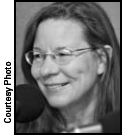 Dr. Kathryn Benzel
Dr. Kathryn Benzel
professor, Department of English
Today Carl Sandburg is all but forgotten amidst the new technologies and curricula that wrap words through virtual space. His visceral depictions of hard working people, their vital environments in the city and on the land, do not fit easily into contemporary critical theories of poetry and literature. His poetry seems almost too simple for any critical analysis, and his politics too obvious for today’s complex political machinations. Even Paul Lauter, an eminent American scholar, forgot to include Sandburg in his recent six-volume anthology of American literature.My recent research is an effort to recover Carl Sandburg from the depths of American literary history and to suggest that his writings (poetry, journalism, reviews, biography of Abraham Lincoln, and folklore) embody the essence of American culture: hardy work ethic, simple colloquial speech, deep respect for the landscape, and belief in the power of the people—all qualities of American democracy.
As I began research in the Sandburg Collection at the University of Illinois at Urbana-Champaign, I discovered a wealth of material in his early career as a platform performer and lecturer. He had a special style of lecture-recital whereby he would read his poetry and play American folk songs on his $25 guitar to create a performance that “wouldn’t bore the audience.”
I also noted that very little attention was given to Sandburg’s poetry about the prairie and to his compilation of American folk songs, “The American Songbag,” both which I believe confirm him as “Poet of the People.” Continuing Walt Whitman’s project to “sing America,” Sandburg performed his vision of the American song and slogan throughout the United States in community venues where everyone was invited and participated.
The essence of these lecture-recitals is found in his Introduction to “The American Songbag”: “The American Songbag” comes from the hearts and voices of thousands of men and women. They made new songs, they changed old songs, they carried songs from place to place, they resurrected and kept alive dying and forgotten songs,” Carl Sandburg, “The American Songbag” (New York: Harcourt Brace Jovanivich, 1927). xiii.
The Sandburg Project evolved from this simple idea of community, bringing together a group of people—performers and audiences—to celebrate American culture. At the risk of seeming artificially patriotic, this project reminds audiences of their roots and national heritage. At various presentations and performances over the past year, the Sandburg Project has brought forward the best of community effort and the audience responds likewise. At the Red Cloud Opera House, Theatre of the American West and Kearney’s Merryman Performing Arts Center, people from the theaters, from the community and the performers all worked together to re-enact Sandburg’s vision.
The program gained immediate attention, because it reached people with the simplicity of the American voice. Nebraska Educational Telecommunications and UNK saw the value of bringing this program to a larger audience and created a partnership to film the April performance.
The Sandburg Project–“Carl Sandburg’s Poetry and Songs: Prayers for the People” was performed again in April at the Merryman Performing Arts Center. That performance was taped by NET and will air on NET in the fall. The performers included Ted Kooser, past U.S. Poet Laureate; our own Dr. Charles Peek; and musicians Mike Adams, Terry Sinnard,Mike Metzger and Cristina Seaborn. A series of companion workshops on poetry and song writing were presented at the Frank House in advance of the performance. In addition, Sandburg scholar Professor Mark Van Wienen spoke at the Frank House on “Carl Sandburg: Pacifist, Patriot, Revolutionary, Detainee.” The performance at the Merryman was preceded with a brief informal lecture about Sandburg’s life and writing.